[from a talk given by His Holiness Radhanath Swami Maharaj in South India Yatra 2010 arranged by ISKCON Chowpatty, Mumbai]
Sri Caitanya Caritamrta Madhya lila Chapter 9 verses 234-241 state: That very night, Sri Caitanya Mahaprabhu and His assistant Krsnadasa arrived at the bank of the Payasvini River. They took their bath and then went to see the temple of Adikesava. When the Lord saw the Adi-kesava temple, He was immediately overwhelmed with ecstasy. Offering various obeisances and prayers, He chanted and danced. All the people there were greatly astonished to see the ecstatic pastimes of Sri Caitanya Mahaprabhu. They all received the Lord very well.
In the temple of Adi-kesava, Sri Caitanya Mahaprabhu discussed spiritual matters among highly advanced devotees. While there, He found a chapter of the Brahma-samhita. Sri Caitanya Mahaprabhu was greatly happy to find a chapter of that scripture, and symptoms of ecstatic transformation – trembling, tears, perspiration, trance and jubilation – were manifest in His body. There is no scripture equal to the Brahma-samhita as far as the final spiritual conclusion is concerned. Indeed, that scripture is the supreme revelation of the glories of Lord Govinda, for it reveals the topmost knowledge about Him. Since all conclusions are briefly presented in the Brahma-samhita, it is essential among all the Vaisnava literatures. Sri Caitanya Mahaprabhu copied the Brahma-samhita, and then with great pleasure He went to a place known as Ananta Padmanabha.
Lord Caitanya came to the holy Payasvini river, bathed, visited the Sri Adi Keshava temple and took darshan of the ancient deity of Lord Visnu reclining on Ananta Sesa. Lord danced, offered obeisances, prayed and loudly chanted the Holy names. In the temple of Sri Adi Keshava, Lord Sri Caitanya Mahaprabhu discussed spiritual subjects with very highly advanced devotees. Bhagavad-Gita Chapter 10 verse 9 states:
mac-citta mad-gata-prana bodhayantah parasparam
kathayantas ca mam nityam tusyanti ca ramanti ca
Lord Sri Krishna tells us in the Bhagavad-Gita that real pleasure is when devotees come together and share their love for Krishna with each other, by discussing the teachings, pastimes and the loving service of the Lord. This is the highest form of relationship, not to get something from each other, not to exploit each other, not to enjoy various temporary thrills with each other. The deepest relations we can have are when we enlighten each other, when we share our love, for God with each other and this is actually one of the tests of how we are spiritually advancing.
Lord Krishna is the Supreme controller: Srila Krishna Dasa Kaviraja Gosvami explains how Brahma-samhita is a supreme scripture which encapsulates the very essence of all the Vedas. It reveals not only the path of perfection and how to achieve it but the highest revelations of spiritual world and the most inner secrets.
Sri Brahma-samhita begins with the verse:
isvarah paramah krsnah
sac-cid-ananda-vigrahah
anadir adir govindah
sarva-karana-karanam
This verse explains how Lord Krishna is the supreme controller. In fact everyone to some extent is thinking that I am controlling my destiny. But isvarah paramah krsnah, there is a supreme controller. Lord Krishna is the controller of all controllers, the supreme controller.
All the things that are attractive in this world Krishna possesses them unlimitedly and eternally. In this world whatever we can have, we can have it only for a little time. Even the most beautiful, lovely, charming people of the past, they are either ashes or washed into the rivers or became food for insects underground. Wealth, fame, beauty you can’t hold on to it, nothing. It all slips through our fingers, however hard we try to cling on to it. But Krishna’s beauty, strength, fame, knowledge, wealth, is not only forever but its forever increasing.
Lord Krishna’s form: Lord Krishna is sac-cid-ananda-vigraha, it is not that Lord Krishna’s body is just a temporary manifestation of goodness for the purpose of helping people to get knowledge and direction in life and then that body merges into nothing, a formless state. Scriptures state sac-cid-ananda-vigrahah, His form is eternal, full of knowledge and full of bliss. He is the origin of everything. Lord Sri Krishna explains in the Bhagavad-Gita 10.8,
aham sarvasya prabhavo mattah sarvam pravartate
iti matva bhajante mam budha bhava-samanvitah
“I am the source of all spiritual and material worlds. Everything emanates from Me. The wise who perfectly know this engage in My devotional service and worship Me with all their hearts.”
Lord Krishna’s abode: Then Brahma-samhita goes on to explain how the scripture was written and what its purpose is. It begins at the highest planet of spiritual world Gokula or Goloka Vrindavana. This is the eternal abode of the Lord and that same Goloka, is manifested in this material world as Gokula Vrindavana. The Gokula in this world is called the manifested spiritual world and Goloka is unmanifested because it is not visible to mundane eyes. But the Brahma-samhita says, premanjana-cchurita-bhakti-vilocanena santah sadaiva hrdayesu vilokayanti. When our eyes are anointed with love of God then we can see the form of Shyamsundar within our hearts. But to the degree that love is absent all that the eyes could see is simply earth, water, fire, air and ether.
Brahma-samhita explains that Lord Krishna is Rasa Bihari. He is the Supreme enjoyer and He is engaging in intimate loving pastimes with Srimati Radharani and all living beings of the spiritual world. He has no direct connection with this material nature. Indirectly through Their expansions,They are manifesting the material existence and sustaining it.
Brahma’s bewilderment: Lord Brahma is born on a lotus sprouting from the navel of the Lord. By the will of the Lord, Brahma had the deep inclination to create, but he didn’t know who he is, he didn’t know what to create, he didn’t know where he was? All around him is nothing but darkness and there is no one else in the universe but him. In order to do big service you have to be willing to go through a lot. Great things don’t come cheaply.
So according to Srimad-Bhagavatam, Lord Brahma after trying a lot, sits down on the lotus flower and the original goddess Saraswati speaks to Brahma. The original Saraswati is an expansion of Srimati Radharani. She tells him to practice chanting an 18 syllable mantra. By the grace of the mantra and by the grace of the Lord he develops an attraction for Govinda. In reciprocation, Lord filled his ears with the song of His flute which was replete with all Vedic knowledge and realizations and eventually he had the vision of the spiritual world. From the total bewildered darkness of desperation he was now actually seeing Krishna’s abode. What he was seeing, what he was feeling, what he loved, he explains and reveals to the world through the verses of Sri Brahma-samhita.
What is of true value? Brahma the original father of all beings, the original spiritual master, is sharing with us what Krishna is revealing to him. In the spiritual world, every grain of dust is ‘chintamani’ more precious than any jewel in this world or in the heavenly abodes. People want diamonds, pearls, rubies, emeralds; because they hope that it is going to satisfy some desire. But they can’t save us from old age, disease and death. They really can’t fulfil any of our desires because what we really desire is happiness and jewels just don’t make you happy, love makes you happy.
The pure devotees have only one desire, to please Lord Sri Krishna and His devotees. This is a consistent prayer among the great souls. Dhruva Maharaja wanted a kingdom greater than his father and his great grandfather but when he saw Lord Vishnu, Dhruva said, I don’t want anything in this world. I was looking for broken pieces of glasses and I have found the precious of all diamonds, greatest of all jewels, that is your loving service. Srila Bhaktisddhanta Saraswati Thakur explains, everything is connected to love because that is truly the only thing that anyone wants, to love and be loved.
Lord Caitanya hand copied Sri Brahma-samhita but now we can have it in our phones. But the question is, are we wiser or more realized or knowledgeable than those people who were copying it in hand or palm leaves. So whatever the form may be, what really matters is our eagerness to hear.
Lord Caitanya travelled for two years through the southern, eastern and western parts of India and He kept two books with Him; Sri Brahma-samhita and Krishna Karnamrita. When He met Ramananda Raya, He gave these two books to him and told him that, “all the wisdom, knowledge and realization that you shared with Me is fully supported in these two books.”
A.C. Bhaktivedanta Swami Prabhupada, the Founder-Acarya of International Society for Krishna Consciousness (ISKCON) explains that the Brahma-samhita was revealed when Brahma was in the maturity of his spiritual realization. And now by Srila Prabhupada’s mercy, millions of people all over the world have received it.
Lord Sri Caitanya Mahaprabhu taught that all of this knowledge is revealed to one who learns how to take shelter of the Holy names. Sri Caitanya Caritamrta Adi Lila 17.22 states: kali-kale nama-rupe krsna-avatara nama haite haya sarva-jagat-nistara “In this Age of Kali, the Holy name of the Lord, the Hare Krishna maha-mantra, is the incarnation of Lord Krishna. Simply by chanting the Holy name, one associates with the Lord directly. Anyone who does this is certainly delivered.”
Just as everything is revealed in Brahma-samhita and other literatures; everything is contained within the names of Sri Sri Radha and Krishna, if we chant with sincerity:
Hare Krishna Hare Krishna Krishna Krishna Hare Hare // Hare Rama Hare Rama Rama Rama Hare Hare.
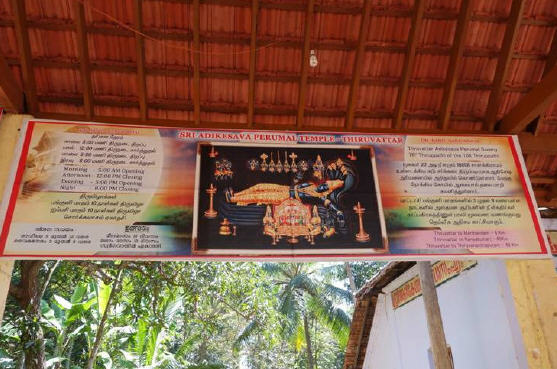
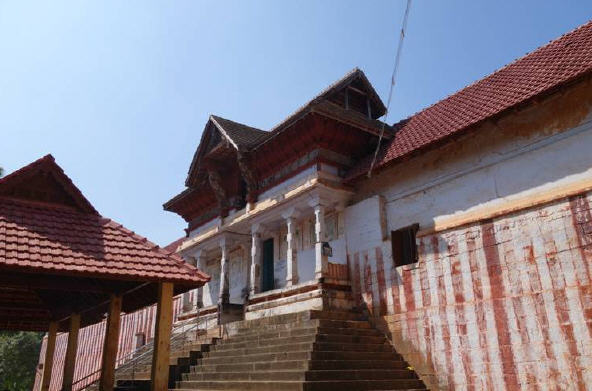
Entrance of Sri Adikeshava Perumal temple, Thiruvattar
One has to climb 18 steps to reach Sri Adi Kesava sannidhi (altar).
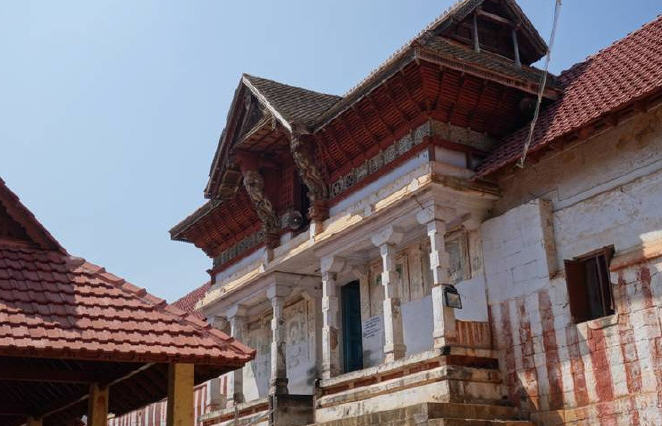
Sri Adikeshava Perumal temple, Thiruvattar
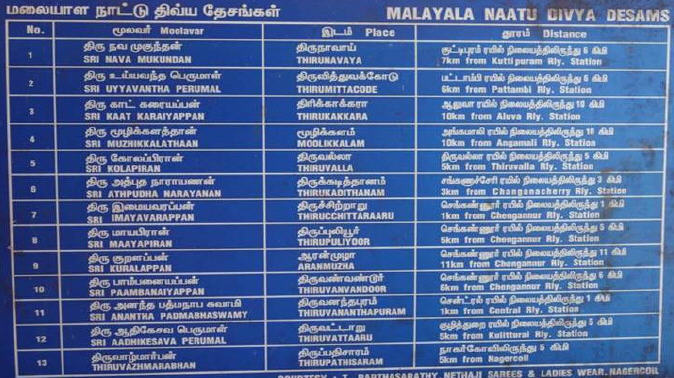
List of Vaishnava divya desam temples in Kerala:
Divya Desams refer to 108 Vishnu temples that are mentioned in the works of the Tamil Azhvars (Vaishnava saints). Divya means “premium” and Desam indicates “place” (temple). Of the 108 temples, 105 are in India, one is in Nepal, and two are outside the earthly realms. The Divya Desam’s are revered by the 12 Azhvars in the Divya Prabandha, a collection of 4,000 Tamil verses. Out of 105 Vaishnava Divya Desam’s that are in India, 13 of them are in the state of Kerala.
The Deity of Sri Adi Keshava Perumal is 22 feet huge, made out of 16008 Saligrams, facing west, Bhujanga Sayanam (sleeping in the opposite direction – Head in the South, feet in the North). The Lord is lying on his snake couch and has to be viewed through three doors. Lord Siva is near the Lord Adikeshava Perumal inside the sannidhi (altar). Sri Adi Keshava Perumal faces west as it is said that He is looking toward Sri Ananta Padmanabha Swamy temple in Trivandrum. This Deity of Adikeshava is considered the elder brother of Sri Ananta Padmanabha Swamy.
One of the unique occurrences at this temple is that between the 3rd and 9th day of Puratasi and Panguni, during dusk, sun’s rays directly falls on the Lord inside the sanctum, almost as a mark of respect from the Sun God to Sri Adi Kesava Perumal. Other interesting facts are: Parasurama is said to have undertaken penance at this place and performed daily poojas for Sri Adi Keshava Perumal; Sage Vashista is said to have stayed here for several years. Another remarkable feature is the Otraikkal Mandapam (single stone hall) outside the main sanctum of the temple altar, measuring 18ft width and 3ft height, that have been built on a single stone in the 12th Century AD.
There are close to 50 inscriptions inside the temple in the outer prakarams in both Tamil and Sanskrit. In addition to the inscriptions, one also finds a number of stunning sculptures on the pillars.
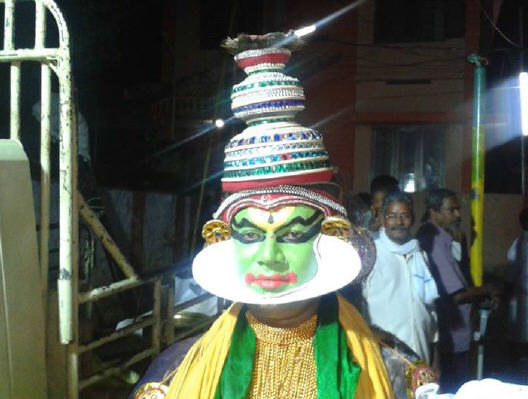
Traditional classical Kathakali dance performance at Sri Adikeshava temple during the festivals for the pleasure of the Lord
In the Kalkulam area of Kanyakumari district, this is a Vaishnava temple built many centuries ago in this place called Thiruvattar totally surrounded by river water. (Thiru is equivalent to Sri in Tamil and denotes auspiciousness, Vatta means circle, aar means river, i.e. a sacred place surrounded in a circle by a river).
In the 108 Diyva Desams this one is 76th in the order. Of the 13 Divya Desams in Malai Nadu (Hill country, in this case the Kerala region), this is an important shrine.
The Moolavar (the Deity) is 22 feet long, and is made of 16008 salagrams in a mortar of kadu-sakkara (a mixture of mustard, molasses, lime and granite), lying on Adisesha in yoganidra. Since the temple is west-facing, He is reclining with His head on the other side.
In front of the sanctum the 18 ft wide and 3 ft high mantap is made of a single stone and is an engineering marvel.
Through the three doorways of the garbagraha, one can view the Lord’s divine feet, arms and face.
Nammalwar (one of the 12 famous Tamil Vaishnava Alwar saints) has sung 11 songs in praise of the Lord.
Alagiya Manavala Dasa, Adityavarma Sarvanga Natha, Veera Kerala Varma are some of the people who have sung about the Lord resident here.
Sri Chaitanya Mahaprabhu came to this temple in 1510 AD, and discovered the 5th chapter of the Brahma Samhita.
In the months of Purattasi (mid Sep-mid Oct) and Panguni (mid Mar-mid Apr), between the 3rd and 9th days, the setting Sun’s rays illuminate the garba graha and it is a divinely wonderful scene.
This temple has beautiful sculptures in stone and wood, in the typical Kerala architectural style.
The special pujas in this temple are Perunthamirdhu Puja, Urchava Bali Puja and Chatur Sata Puja.
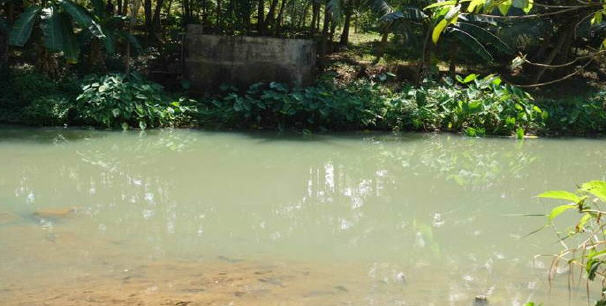
Thiruvattar river where Lord Sri Caitanya Mahaprabhu took bath before visiting Sri Adi Kesava temple
This river flows about 100 meters from the main entrance of Sri Adi Kesava Temple. This is where Lord Sri Caitanya Mahaprabhu took bath before taking darshan at Sri Adi Kesava Temple. A small pathway in front of the main entrance of the temple leads to this river
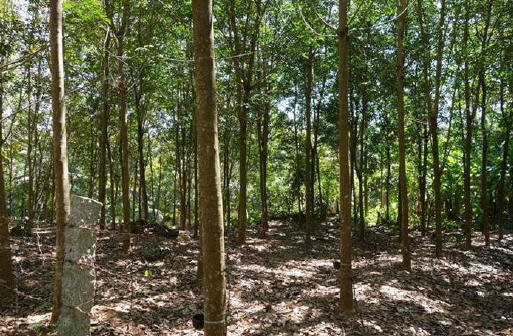
Beautiful Rubber trees grove near Sri Adikeshava Perumal temple on the way to Thiruvattar river
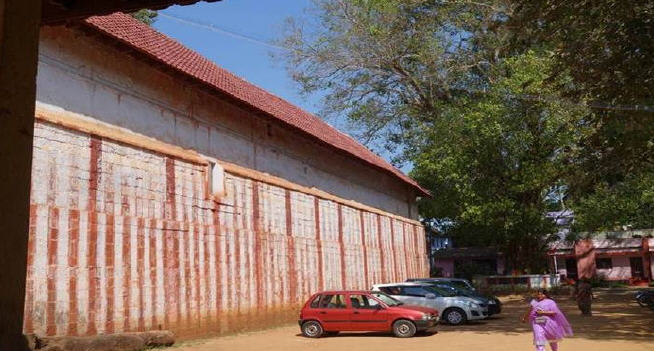
Sri Adikeshava Perumal temple, Thiruvattar Temple is surrounded by a massive 30-foot tall wall Adjacent to Sri Adikeshava Perumal temple there is an ancient Lord Nrsimhadeva Temple
